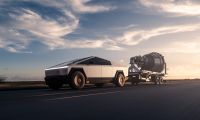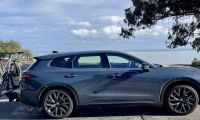Of course that depends on what’s behind that question and the way we dissect this news about Kia’s sales successes. Let’s look at the details of their press release and sales figures more closely, and then consider what this means.
First, Kia announced that their EV model sales are up 41 percent over September 2021. That sounds great, doesn’t it? While it certainly is good news that more Kia EVs are on the market and actively helping us address our little problem with carbon emissions and other toxic emissions from fossil fuel powered personal transportation, we should remember that Kia only had a single EV on sale in the U.S. last year, the Kia Niro EV. Kia does not break down their sales numbers for the different variants of the Niro, much to auto journalists’ chagrin, but there are three variants. The hybrid (HEV) version, the plug-in hybrid (PHEV) and EV version. Kia only sold 2,566 Niros in the U.S. in September last year, and that was for all 3 variants combined. The HEV version was most likely the largest subset of those, followed by the EV and then the PHEV versions. So, it is likely that Kia sold no more than about 1,000 Niro EV’s last September. That doesn’t really sound like a lot of EVs, and it can’t be too far off because this September, Kia has two EVs on sale, the EV6 and the Niro EV. Since Kia sold 1,440 EV6s last month, which is slightly more impressive, and they only sold a combined total of 191 Niros (remember, all three variants there), you can see that the only reason Kia’s EV sales are up is in fact because the EV6 is a successful EV. If it weren’t for the EV6, Kia’s headlines would actually be about a gloomy and precipitous decline in their EV sales, in fact. So thank goodness for the EV6, but if we stop for just a second and look at the EV6 sales numbers for previous months, we would actually see that September 2022 is actually the worst sales month yet for the EV6, in the U.S., since it went on sale in February. What gives?
Obviously, it is in Kia’s best interest to put a positive spin on their sales numbers, and it is absolutely true that their EV sales are up, year-over-year. But let’s call this for what it is, small potatoes. This is especially true when we look at Kia’s closest competitor amongst the legacy automakers: Ford, whose EV sales are up 197.3 percent, year-over-year.
But there’s something else to take away from Kia’s sales figures and I find it somewhat discouraging. Although Kia’s total sales are up 6.4 percent year-over-year, leading to its highest third quarter performance in history (all very exciting stuff, for Kia), it is entirely due to the sales of SUVs and crossover vehicles as all of Kia’s smaller, more fuel efficient vehicles saw their sales decline year-over-year. Big deal you might say, Americans love their SUVs and crossovers so it makes sense that is what they are buying. But regardless of fuel type, bigger vehicles have greater emissions, in their manufacturing due to additional raw materials and components or size, and in the efficiency by which they transport us. Other than the EV6, we don’t know how many more efficient electrified SUVs Kia sold in September or for the entire year, but I would bet dollars to donuts that it isn’t as many as Kia has otherwise hoped to manufacture and sell. They would have called this out if it were the case. I have read that Kia may even be favoring traditional ICE variants over electrified versions of their SUVs, like the Sportage and Sorento Hybrid and PHEVs, because they are faster to produce (and cheaper too, of course). So I say take Kia’s sales success with a grain of salt. While I am glad Kia is cranking out more EVs than they did last year, and at least some number of hybrid and plug-in hybrid versions of their most popular SUVs, they are churning out far more of the gas only variants which means Kia is not truly on track to meet their electrified sales goals, at least for the U.S. How much that might be driven by Kia’s loss of the federal electric vehicle tax credit or the global supply chains issues isn’t something we can easily know. But certainly, the combination of these two things is dragging on Kia’s electrified sales figures in a more negative way than their headlines would otherwise suggest.
What do you think? Please leave your comments and questions below.
Images courtesy of Kia and Justin Hart.
Justin Hart has owned and driven electric vehicles for over 14 years, including a first generation Nissan LEAF, second generation Chevy Volt, Tesla Model 3, an electric bicycle and most recently a Kia Sorento PHEV. He is also an avid SUP rider, poet, photographer and wine lover. He enjoys taking long EV and PHEV road trips to beautiful and serene places with the people he loves. Follow Justin on Twitter for daily KIA EV news coverage.












